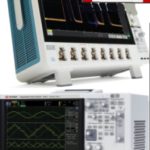Many moons ago, a future member of our editorial staff was playing with his very first multimeter. He was a farm kid. One of his first experiments was to put the negative lead of the meter on a ground rod and the positive lead on one of the metal bands used to  reinforce the interlocking concrete staves that formed a feed silo on his family’s farm. To his great surprise, the meter registered a voltage, though the metal band wasn’t connected to anything electrical. Moreover, the higher the metal band on the silo, the greater the voltage.
reinforce the interlocking concrete staves that formed a feed silo on his family’s farm. To his great surprise, the meter registered a voltage, though the metal band wasn’t connected to anything electrical. Moreover, the higher the metal band on the silo, the greater the voltage.
This kid’s first thought was that his new meter wasn’t working correctly. The mystery wasn’t solved for him until a few years later when college physics instructor explained the concept of atmospheric electricity: Air above the surface of Earth is positively charged, while the Earth’s surface charge is negative. For every meter higher in the air, the voltage rises by around 100 V, i.e. by 100 V/m. This atmospheric potential gradient extends up to about 50 km above the earth. The result is an ion flow from the positively charged atmosphere to the negatively charged surface of the earth.
With this effect in mind, it is easy to see why static discharge is a formidable hazard in (tall) grain elevators due to the possibility of dust explosions. Of course, the atmosphere isn’t the only source of static charges. Electrically neutral objects become charged positively whenever they lose electrons and charged negatively whenever they gain electrons. In triboelectric charging there is a transfer of electrons from one object to another because of friction. One classic example of the effect is the rubbing of a vinyl balloon on human hair. The vinyl gains electrons and becomes positive while the hair loses them and picks up a negative charge. But dangerous triboelectric hazards can be present in sawmills or wood-plaining mills in which fine, dry sawdust is suspended in the air. If the dust is blown through a metal duct, the friction of rapidly moving fine, dry wood dust on the inside of the duct can cause static accumulation, electrical discharge and an explosion.
 Of course, not all materials exhibit the static electric effect. Otherwise, we would leave a trail of sparks everywhere we go. Materials that exhibit this interesting phenomenon are known as triboelectric materials, and are members of the triboelectric series. Typically, modern versions of the triboelectric series are based on various properties including the time required for a material to acquire an electric charge relative to other materials in the series and under specified conditions. The farther apart in the list the two materials appear, the greater the charge transferred. Between metals, there is little or no measurable charge transfer because charge rapidly conducts away from the surface.
Of course, not all materials exhibit the static electric effect. Otherwise, we would leave a trail of sparks everywhere we go. Materials that exhibit this interesting phenomenon are known as triboelectric materials, and are members of the triboelectric series. Typically, modern versions of the triboelectric series are based on various properties including the time required for a material to acquire an electric charge relative to other materials in the series and under specified conditions. The farther apart in the list the two materials appear, the greater the charge transferred. Between metals, there is little or no measurable charge transfer because charge rapidly conducts away from the surface.
Liquids can be triboelectric materials. Fluids characterized by conductivity below 50 pS/m are known as static accumulators because they behave like insulators. Cargo ships and trucks must be as careful when handling static accumulator liquids as when handling flammable liquids: When a static accumulator liquid flows through the pipeline, the pipeline looses some of its electrons. The liquid gains these electrons and becomes negatively charged. When the liquid enters an empty tank, it splashes, again increasing the static charge generation. To avoid this charge generation and potential catastrophes, shippers limit the rate of flow during filling and adopt procedures to reduce the splashing of the liquid in the tank.
Unfortunately it is generally not possible to measure static electricity with a multimeter because the input impedance is too low. Static charge is generally measured in terms of kilovolts and its measurement requires an instrument with a high input impedance. An electrostatic fieldmeter, also called a static meter, is the usual choice. It measures the force between the induced charges in a sensor and the charge present on the surface of an object, then converts this force to volts, measuring both the initial peak voltage and the rate at which it falls away.

Less destructive and more interesting illustrations of static electricity power can be found on YouTube videos that explain how to construct corona motors powered by atmospheric electricity. Videos we’ve seen use a power source consisting of wire extending about 400 ft high, generally with several sharp points (often sewing pins) at the top to concentrate charge. The setup generates a current in the low microamp range.

In operation, a negative electrode sprays negative charge onto the section of the cylinder it faces. Like charges repel each other so the negative charge on the electrode repels the negative charge on the cylinder. But charges can’t go anywhere on the electrical insulator cylinder. Instead they repel, pushing the cylinder, and the cylinder begins to rotate. The blades are usually at an angle to the cylinder, causing charge to spray on the cylinder more in the direction angle.
As it rotates, the negatively charged section of the cylinder approaches the next electrode which is positively charged. Unlike charges attract each other. So the negatively charged section is attracted by the positively charged electrode. As the negatively charged section passes the positively charged electrode, ionization removes the negative charge from that section, leaving it positively charged. The now positively charged section is repelled by the positively charged electrode. The positively charged section approaches the next electrode which is negatively charged. The unlike charges attract, and the positive section is attracted by the negative electrode.






Leave a Reply
You must be logged in to post a comment.